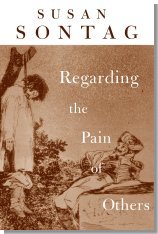 |
 |
 |
 |
 |
 |
|
|
|
|
|
|
|
 Regarding the Pain Of Others READ AN EXCERPT ________________________________________________________ |
||
 |
One of the distinguishing features of modern life is that it supplies countless opportunities for regarding (at a distance, through the medium of photography) horrors taking place throughout the world. Images of atrocities have become, via the little screens of the television and the computer, something of a commonplace. But are viewers inured -- or incited -- to violence by the depiction of cruelty? Is the viewer's perception of reality eroded by the daily barrage of such images? What does it mean to care about the sufferings of people in faraway zones of conflict? Susan Sontag's now classic book On Photography defined the terms of this debate twenty-five years ago. Her new book is a profound rethinking of the intersection of "news" art, and understanding in the contemporary depiction of war and disaster. She makes a fresh appraisal of the arguments about how pictures can inspire dissent, foster violence, or create apathy, evoking a long history of the representation of the pain of others -- from Goya's The Disasters of War to photographic documents of the American Civil War, lynchings of blacks in the South, the First World War, the Spanish Civil War, the Nazi death camps, and contemporary images from Bosnia, Sierra Leone, Rwanda, Israel and Palestine, and New York City on September 11, 2001. This is also a book about how war itself is waged (and understood) in our time, replete with vivid historical examples and a variety of arguments advanced from some unexpected literary sources. Plato, Leonardo da Vinci, Edmund Burke, Wordsworth, Baudelaire, and Virginia Woolf all figure in this passionate reflection on the modern understanding of violence and atrocity. It includes as well a stinging attack on the provincialism of media pundits who denigrate the reality of war, and a political understanding of conflict, with glib talk about a new, worldwide "society of spectacle:' just as On Photography challenged how we understand the very condition of being modern, Regarding the Pain of Others will alter our thinking not only about the uses and meanings of images, but about the nature of war, the limits of sympathy, and the obligations of conscience. "Sontag is in top form: firing devastating questions and providing no answers for shelter. She hands us no morality meter." —Neal Ascherson, Los Angeles Times Book Review "Sontag, one of our most perceptive and valiant thinkers, offered a seminal critique of camera-mediated images in On Photography. Now, 25 years later, photographs and video of the bloody consequences of terrorism and war routinely fill the media, and Sontag offers a fresh, meticulous, and deeply affecting dissection of the role images of suffering play in our lives . . . Writing with electrifying clarity and conciseness, Sontag . . . [is] scrupulous in her reasoning and exhilarating in her arguments." —Donna Seaman, Booklist "Her books illuminate without simplifying, complicate without obfuscating, and insist above all that to ignore what threatens us is both irresponsible and dangerous." —O magazine "Regarding the Pain of Others bristles with a sense of commitment–to seeing the world as it is, to worrying about the ways it is represented, even to making some gesture in the direction of changing it... the performance is thrilling to witness."—The New York Times Magazine "Wise and somber... Sontag’s closing words acknowledge that there are realities which no picture can convey."—Los Angeles Times Book Review "A fiercely challenging book...immensely thought-provoking." —The Christian Science Monitor |
 |
 |
||
HOME | PRIZE FOR TRANSLATION | SUSAN SONTAG | ABOUT | EVENTS | DONATE
© 2010 Estate of Susan Sontag. All Rights Reserved.